|
SUMO CONTENTS
1. The Characteristics of Sumo
2. The History of Sumo
3. Sumo Today
4. Introductory Summary
of The Main Sumo Rules
THE CHARACTERISTICS OF SUMÓ
(Chapter 1)
Sumó is a competitive sport, practiced between individuals in a dohyo
(ring). The management of the proceedings and all decisions are the responsibility of a referee, known as a gyoji or shushin.
To ensure fairness, he is assisted by four judges, and the addition of a chief judge with the responsibility of supervising
the other judges, brings the total number of judges to six. No protest or objection will be recognized from anyone other than
these judges.
The first point to which particular attention needs to be paid in
a sumo bout is the act of tachiai (rising to begin the bout). It is no exaggeration to say that seventy percent of the outcome
is determined at this point. It is therefore a Fundamental principle of sumo that the tachiai must take place under conditions
of complete equality for both wrestlers. They should both touch their hands to the ring and rise at exactly the same moment.
The referee is responsible for seeing that the rhythm of their breathing - inhaling and exhaling - is precisely coordinated.
In sumo, as in all the martial arts of Japan, courtesy
and ritual are respected and the bouts commence with a ritual act of courtesy by both wrestlers. The special rituals of sumo
consist of rituals (standing ritual!) and chirichozu (pledging ritual). The chirichozu ritual is unique to sumo and derives
from the custom of purification before a battle.
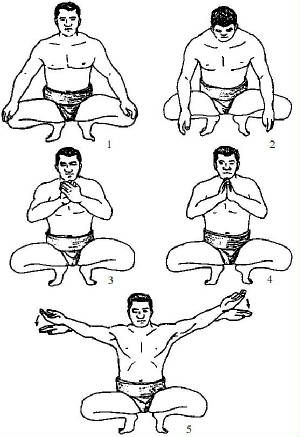
|
| Chirichozu |
It is carried on by both sumo wrestlers
at the same time when they climb up into the dohyo. Each wrestler sits in a particular posture called sonkyo (crouching) just
inside the dohyo, exchanges nods with his opponent, rubs and then claps his hands once, stretches out both arms horizontally
with palms upwards, turns down his palms, and then completes the ritual by returning both hands to rest on his knees.
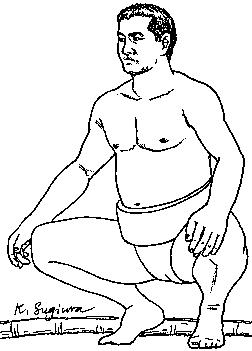
|
| Sonkyo |
The dohyo is comparatively small with a diameter of 455 meters. All
respect is due to the ancient Japanese who designed the dohyo in the form of a circle, since a circle represents infinity.
In other words, the round dohyo can be utilized as an area of infinite size, and this has resulted in a considerable enhancement
of sumo techniques. This is the reason why sumo is regarded as one of the most difficult sports of its kind in the world,
and it continues to be fought with no regard for differences in physical characteristics between wrestlers. Another characteristic
of sumo is that the wrestlers are naked apart from a narrow loincloth, called a mawashi, and together with the circular form
of the dohyo, this has also made a considerable contribution to the development of sumo techniques.
Chapter 2
THE HISTORY OF SUMÓ
Sumo, the national sport of Japan, has a history of over a thousand years. It has some
similarity to boxing and wrestling, and a sport resembling sumo is practiced in the Soviet Union and
in North and South Korea. References to it can also be found
in Indian and Chinese historical records, and pictures of it can be seen in ancient Greek murals. Ancient history also tells
us that the winner in sporting competitions resembling sumo received the highest praise during the festival of the Olympiad.
It can therefore be said that sumo was played throughout the world in ancient times, with no regard for differences between
East and West.
The specific features of Japanese sumo developed over time in harmony
with the climate and natural surroundings of Japan and the
cultural and spiritual characteristics of the Japanese people. The first reference to sumo in Japanese history is to its use
in mythological times in a duel. The history of sumo really starts in the 8th century when it was performed for the Emperor
at court banquets. From that time on, sumo became one of the regular functions arranged at the annual court banquets, and
this tradition continued for some 400 years. These matches were held not in a dohyo but on the plaza in front of the Shishin-den
(Imperial throne room).
With the development of feudalism after the 10th century and the
ascendancy to power of the warrior classes, sumo came to be widely practiced as a fighting technique among warriors (1192-1580).
Thereafter, the style of warfare changed, coming to depend more on actions by groups than by individuals, and sumopassed out
of the hands of the warriors into those of the common people, among whom professional sumo wrestlers appeared.
During the Tokugawa Shógunate era from 1603 to 1867 professional
sumo wrestlers were supported by the feudal lords. With the collapse of feudalism at the end of the Tokugawa era, they began
to make their own living with support from the townspeople. Closely linked to shrines and temples, matches were held to raise
money for their construction and repair. This form of sumo was known as Kanjin Sumo, which later developed into the present
Japan Sumo Association of professional sumo wrestlers. The Japan Sumo Association has preserved its links with this long historical
tradition, two visible manifestations of which can be seen in the shinden (shrine housing a deity in a Shinto shrine) form
of the roof suspended over the ring, and in the clothing worn by the referee, symbolizing a Japanese warrior of the past in
hunting dress.
Chapter 3
SUMO TODAY
Both amateurs and professionals take part in sumo today, working
together in harmony, preserving their own spheres and contributing to the overall development of sumo. Professional sumo underwent
various organizational changes from the Edo era 1onwards until in 1925 the Japan Sumo Association was
constituted as a body with special juridical status. It has striven to raise the level of techniques and the standards of
those engaged in sumo and to encourage pride in the professional status of being a sumo wrestler.
Amateur sumo can be divided organizationally into Young Sumo for
pupils from primary and junior high schools, Student Sumo for students from senior high schools, colleges and universities,
and Adult Sumo, embracing teachers, young people, clubs from industrial and commercial enterprises, and sumo fans from among
the general public. Each group has its own nationwide system and all enjoy wide popular support.
These various groupings are backed by the Nihon Sumo Renméi (Japan
Sumo Federation), the largest and most authoritative organization of amateur sumo in Japan.
At present, sumo in Japan
is enjoying a period of unprecedented prosperity with close cooperation between amateur sumo, participated in by people from
every walk of life, and the spectator sport of professional sumo.
The practice of sumo has also made a substantial contribution to
improvements in the physique of the Japanese people, and participation in sumo may be expected to continue to play an important
part in raising the basic level of physique of the people in future.
The hope of the Japan Sumo Federation is to disseminate knowledge
and the practice of sumo among all the peoples of the world. A start was made in July 1983, when the International Sumo Organization
was founded by Japan and Brazil.
The hope and aim of those involved is to foster and strengthen this organization so that it develops into the International
Sumo Federation, and in the near future to sponsor and organize international sumo championships. In accordance with this
aim, for the past five years the Japan Sumo Federation has encouraged and sponsored participation by teams from Brazil,
America and West Germany,
as well as teams drawn from the representatives of various countries in Japan,
in the All Japan Amateur Sumo Championship, and participation by a team from South Korea
is promised for 1985.
Chapter 4
INTRODUCTORY
SUMMARY OF THE MAIN SUMÓ RULES
Wrestlers
1. A wrestler must be naked, except for a loincloth
called a mawashi. However, if permission is given by the Japan Sumo Federation, sumo pants may be worn).
2. A wrestler cannot ask for "time" after the referee has said that
time is up.
3. A wrestler has no right to protest against the decision made by
the referee. No one other than one of the judges is permitted to protest against the referee's decision.
4. Once a decision has been made, both wrestlers must retreat to
the tokudawara and exchange nods. There the winner, in a crouching posture, receives the form notification of victory.
Referee
1. Matches are presided over by a referee.
2. In addition to presiding over the matches, the referee watches
carefully for an unauthorized techniques (kinte).
3. Four judges sit at the North, East, South and West sides respectively,
and the chief judge sits in front of the dohyo on the North side.
4. In the case of disagreement among the judges, the chief judge
will listen to each judge and decide on the winner in accordance with the majority opinion. If both competitors are supported
by an equal number of judges, the chief judge may order a rematch.
Match Decision
1. A competitor loses the bout when any
portion of his body other than the soles of his feet touches the surface of the dohyo.
2. A competitor wins when he pushes his opponent over the outer boundary
of the dohyo.
3. When both competitors touch the surface of the dohyo inside or
outside at the same time, a rematch is called.
Unauthorized Techniques (Kin-te)
Techniques most likely
to cause injury, namely boxing and certain types of kicking and thrusting, are forbidden as a matter of general principle.
The unauthorized techniques established at the present time by the Japan Sumó Federation are described on page 21. Anyone
using an unauthorized technique will lose the bout.
Shikiri
The posture adopted by a wrestler starting
a bout is called shikiri.
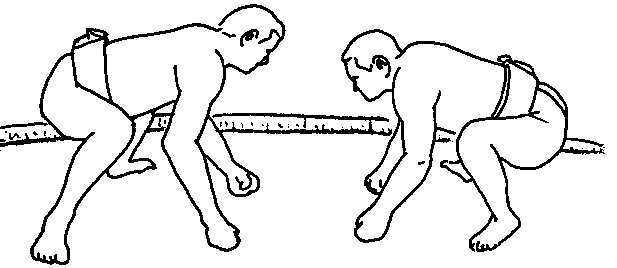
|
| Shikiri |
This is formed with both feet
apart, the upper part of the body bent forward with the hips and shoulders in a horizontal line, and with both hands placed
on the ring. Similar to the starting posture of a runner, this is called the shikiri or tachi.ai posture and is the `ready'
position for wrestlers.
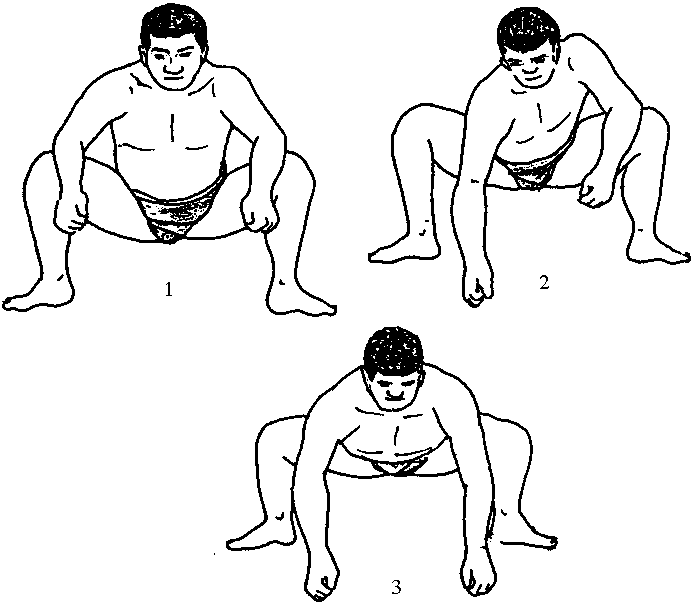
|
| Assuming shikiri |
Shiko
This is one of the training methods used by wrestlers to strengthen their legs and hips. As depicted in the drawings
below, starting from a squatting position with knees spread apart and the palms of the hands on the knees, one leg is raised
to its maximum height sideways and this position is held for 1 or 2 seconds. This leg is then brought back with a stamp and
the other leg raised.
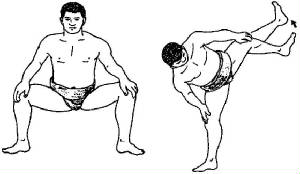
|
| Shiko |
Ring (dohyó)
1. The perimeter of the ring, with
a diameter of 455 meters, is formed of straw bags (tawara) or other bags, filled with earth; the bags are moved back at the
four sides to form a space (tokudawara).
2. The circular ring is formed within
a square with sides measuring 727 meters.
3. The surface of the dohyo must
be perfectly smooth; an appropriate amount of sand may be strewn on it.
Implements
Apart from the loincloth, called mawashi or shimekomi,
no external aids or
implements are permitted. The width of the loincloth is 40 cm; no particular length is prescribed,
but it should be sufficient to pass four or five times round the body. The loincloth is normally folded in four lengthwise;
it should be sufficiently tough so that it does not crumple up when grasped by an opponent. For youngsters the material can
be more flexible and for primary school children the use of sumo pants is permitted.
Chapter 5
OFFICIAL
SUMÓ RULES (NIHON SUMÓ RENMÉI)
Sumo matches held under the auspices of the Japan Sumo Federation
are conducted in accordance with the following rules.
V-1. Competition Rules
Section 1: General Rules
1. Matches arranged by this Federation
or by affiliated bodies shall be performed in accordance with these rules.
2. A committee shalt be formed to deal with match preparations and
post-match
arrangements.
3. The President shall nominate committee members.
Section 2: Competition Officials
4. The following officials
shall take charge of competition arrangements:
1) President;
2) Vice President;
3) Championship Committee Chairman;
4)
Championship Committee Deputy Chairman;
5) Chairman of the General Affairs Committee;
6) Deputy Chairman of the General
Affairs Committee;
7) Members of the General Affairs Committee;
8) Chairman of the Match Committee;
9) Deputy Chairman
of the Match Committee;
10) Chief of Judges;
11) Deputy Chief of Judges;
12) Judges;
13) Judging Secretary;
14)
Officials responsible for specific arrangements (ceremonial arrangements, awards, decisive techniques, broadcasting, progress
of events, record-keeping, convening, i selection, location, putting the location in order, publicity, reception arrangements,
general affairs, accounting and looking after guests, security, first aid, accommodation, transport, despatch of materials
etc, notices and bulletins, liaison, dohyo);
15) Medical Committee Members.
5. The following officials may be appointed for a competition:
1)
President;
2) Honorary Chairman;
3) Honorary Advisers;
4) Eminent Guests;
5) Honorary Members;
6) Advisers;
7)
Consultants;
8) Championship Committee Members.
6. The Competition officials are selected by a Preparatory Committee
and formally nominated by the President.
Section 3: Qualifications for Participation and Application Procedures
7.
Participation in matches held under the auspices of this Federation or affiliated bodies is limited to those persons described
below:
1) in the student section, those persons covered by the conditions of the Japan Student Sumo Federation;
2) in
the senior high school section, those persons covered by the conditions of the Sumo Section of the All Japan Senior High School
Sports Federation;
3) in the general section, junior high school pupils, young people, members of the public, company based
groups, teachers, also those persons not included in the preceding two sections.
4) Persons mentioned in the preceding
sections who break the rules of amateur sumo will forfeit their qualifications.
8. In the case of participation by teams, the composition of the
teams will normally be as follows:
1) for student teams 7 persons and 1 supervisor;
2) for senior high school teams
7 persons and 1 supervisor;
3) for public teams from prefectures or metropolitan districts 4 persons and 1 supervisor;
4)
for teams of young people from prefectures or metropo6tan districts 4 persons and 1 supervisor;
5) for company based teams
4 persons and 1 supervisor;
6) for teams of teachers 4 persons and 1 supervisor;
7) for junior high school teams 4 persons
and 1 supervisor.
It should be noted that, depending on the competition, the Preparatory Committee has the power to increase
or decrease the number of persons.
9. Applications must be made in the prescribed form, containing the
following details for each competitor: name, age, occupation (school or college year), height, weight, order of appearance,
and rank, also the name of the supervisor. Applications must be accompanied by a health certificate for each person and must
be made to the secretariat of the Preparatory Committee by the prescribed date. No applications will be admitted after the
prescribed date for any reason whatever.
10. No alteration may be made to items written down in the application.
However, this limitation does not apply if, prior to the draw taking place, the permission of the Preparatory Committee is
obtained
Section 4:
11.
The dohyo (ring) must conform to the standards of the Japan Sumo Federation.
12. There are separate competition methods, one for teams and the
other for individuals.
13. In the case of competition by teams, if a small number of teams
participate, the competition is arranged in the league style; if a large number of teams participate, the pattern of competition
between teams is decided on the basis of a lottery, and preliminary bouts (the number of such bouts to be decided by the Preparatory
Committee) will be held. On the basis of the team victories gained, teams will enter a tournament style competition; the number
of teams going forward to the tournament to be decided in accordance with the figures given in para IS below.
14. The superior team is decided on the basis of the team victories
gained. In the event of equal team victories, the decision is based on the total number of individual victories gained. In
the event of an equal number of team and individual victories, it is made according to the following procedure. In the case
of four or more teams, a decision will be made on the basis of a tournament-style or a reverse tournament-style (losers remain)
competition; while in the case of three teams it will be on the basis of a league-style competition.
With regard to the
tournament-style competition mentioned above, it should be noted that if a team victory is decided before all the members
have played, the match may be broken off before completion.
15. The number of superior teams permitted to go forward will be
as follows:
1) in the case of 24 or less participating teams, 8 teams.
2) in the case of 25 or more participating teams,
16 teams.
3) in the case of 50 or more participating teams, 32 teams.
16. In the case of competition by individuals, the procedure is as
follows:
1) all participants will take part in a tournament-style competition on the basis of a lottery; or
2) participants
will first take part in preliminary bouts and the winners, decided on the basis of points gained, will take part in a tournament-style
competition; the combination of players to be decided on the basis of a lottery; or
3) participants are divided into a
number of groups and the best persons are selected from each group to take part in a formal playoff. In the case of large
numbers, the combination (who fights whom) will be arranged in the form of a tournament-style; in the case of small numbers,
in the form of a league-style competition; or
4) when preliminary bouts by teams are combined with preliminary bouts by
individuals; participants will be decided on the basis of individual results and the combination decided on the basis of a
lottery.
Competition methods in cases where the above principles do not apply will be decided separately by the Preparatory
Committee.
17.In team competitions, matching the teams, i.e. deciding which
team fights which, will be decided on the basis of a lottery by the preparatory Committee. However, matching on the day of
the competition will be the responsibility of the Match Committee Chairman.
1) In the event of an odd number of teams,
the odd team out will be matched with the team gaining the lowest number of points in that round. In the event of two or more
teams being in the lowest position, a choice will be made by lottery.
2) In the event of withdrawal by a matched team or
teams, victory will not be awarded automatically to the opponent but matching will be carried out on the basis of the following
principles:
a) In the event of one team withdrawing:
if there is an odd number of teams, the opponent of the withdrawn
team will be matched with the odd team out; or if there is an even number of teams, the opponent of the withdrawn team will
be matched with the team with the lowest number of points in that round.
b) In the event of two teams withdrawing:
if
there is an odd number of teams, the two opponents of the withdrawn teams will be matched, and the odd team out will be matched
with the team having the lowest number of points, as in 17. 1 above; or
if there is an equal number of teams, the two opponents
of the withdrawn teams will be matched.
c) In the event of three or more teams withdrawing, matching of the opponents of
the withdrawn teams will be on the basis of a lottery.
18. In the event of a team competing as the team with the lowest
number of points; if such a team gains more points than in a previous preliminary bout, the higher score will be the one to
be formally recorded.
19. The matching of competitors will be in the order as given in
the application. However, if the permission of the Preparatory Committee is obtained, this limitation need not apply.
20. Replacement of one competitor by another is limited to those
competitors listed in the application form.
21.In the event of a replacement player competing, notification must
be made to and approval obtained from the Match Committee Chairman. The replaced player is not permitted to compete again.
In the event of a player competing without permission, that particular bout will be considered as invalid.
22. In the event of a replacement player competing, he will succeed
to the scores and order of the preceding players in the case of team matches only.
23. If the numbers do not reach a majority of the required numbers
even by adding a replacement player or players, the opposing team shall be declared the winner without a match taking place.
24. Replacement of players in an individual competition is not permitted.
However, a replacement player as specified in 16. 4 above may earn the right on the basis of his scores to go forward as an
individual.
25. A team which absents itself from the competition without permission
will be dealt with by the General Affairs Committee. A team will be recognized as such if more than a majority of players
appear.
26. All bouts are decided on the basis of a single victory or defeat.
It is a fundamental principle that both players must rise after touching the ring with both hands.
27. The lines behind which the wrestlers must crouch and touch their
hands to the dohyo are 70 cm apart. The width of these white lines is 5 cm and the length 70cm.
28.In the course of a match, when a competitor's name is called twice
by the official in charge of the progress of events and he fails to appear, he will be deemed to have no intention of appearing
and be treated accordingly.
29. Teams or competitors who arrive after the start of the competition
will not be permitted to take part.
30. If any team or competitor, after making an application and without
a valid reason, either fails to appear, or appears while deviating from the particulars listed in the application, or cancels
and withdraws from the competition while it is in progress, the General Affairs Committee may decide that they shall not be
permitted to appear at the next competition.
31. Important matters arising on the day of the competition shall
be dealt with in
accordance with the decision of the General Affairs Committee.
V-2 Rules Concerning Judging
1. The Preparatory Committee will select judges from among those
persons formally qualified as judges and the Chairman will make a request to them.
2. At the competition all matters related to judging shall be dealt
with by the chief of judges (one person), and by (a number of persons in each case) the deputy chief of judges, referees and
judges (including two judging secretaries).
3. The chief of judges will deal comprehensively with all matters
pertaining to judging, can convene a Judging Committee if considered necessary, and will bear all responsibility for judging.
The
deputy chief of judges will assist the chief of judges and may deputize for him on occasion. Either the chief or the deputy
chief of judges will act as a chief judge during a competition at the side of the ring.
4. The persons designated as judging secretaries among the judges
will allocate judges and deal with all other administrative matters affecting judging.
5. The referee and the judges will be responsible for deciding the
winner and loser and other questions related to judging.
6. Judging in a competition is the exclusive responsibility of the
appropriately designated judges.
7. There wr11 normally be six judges, but on occasion there may be
four. In such a case, one will be the chief judge, one the referee, and the others judges.
8. In the event that the chief judge or a judge has an objection
or doubt regarding a decision of the referee, this must be put to the referee and a meeting convened immediately. Such a meeting
of al1 the judges will take place in the dohyo.
9. In the case of such a meeting, the chief judge will preside and
pass judgement.
10. An objection to a decision on the result of a bout can only be
made by one of the designated judges for that particular competition.
11. No objection of any kind will be permitted after one of the competitors
has received the formal notification of victory.
12. The wrestlers will rise to begin the bout (tachiai), when the
referee calls on them to do so. It is customary to have two preliminary trials of shikiri before the actual fighting begins.
13. If no decision has been reached within 5 minutes after a bout
has begun, the bout will be broken off and followed immediately by a replay. In the case of
primary and junior high school
pupils, the time is 3 minutes.
14.If during the course of a bout one of the judges observes a wrestler's
hand touching the surface of the ring (hakite), or foot stepping outside the ring (fumikoshi), he should not make an objection
immediately, but should report to the referee immediately the bout has finished.
15. If during the course of a competition the referee mistakenly
announces that the
result of a bout is decided, the bout will be restarted.
16. If as a result of injury or bleeding it is judged impossible
for a bout to continue, it will be stopped and the result announced following a meeting of the judges.
17. If a competitor decides of his own accord to stop fighting and
withdraw, the judges may decide that he has lost.
18. A competitor will be judged to have lost if one of the following
circumstances applies:
1) he touches the surface outside the dohyo before his opponent;
2) any part of his body other
than the soles of his feet touches the surface of the ring before his opponent; however, he will not be judged to have lost
if the case is considered one of kabaite (when a wrestler decisively throws his opponent and his hand touches the ring before
his opponent) or of okuriashi (when a wrestler forces his opponent out of the dohyo and his own foot accidentally touches
outside while the technique is being completed);
3) if during a bout he is lifted by his opponent higher than the hips
and the further action is judged to be dangerous;
4) if he is judged unable to continue the bout as a result of injury
etc; 5) if he fails to obey the instructions of the referee.
19. In the case of forbidden techniques (kinte) being employed, the
bout will be stopped immediately and the player using them will be judged the loser after a meeting of the judges.
Forbidden
techniques are as follows:
1) Slapping from the side (particularly the ears).
2) Thrusting with the fingers or fist
(e.g. at the eyes or pit of the stomach); 3) grabbing (e.g. the hair, throat, front vertical part of the mawashi);
4) Kicking
(other than with the sole of the foot below the thigh); 5) twisting the fingers the wrong way;
6) Biting.
The judge
will instruct a wrestler holding the posterior vertical part of his opponent's loincloth to release it.
20. If a judge mistakenly judges a forbidden technique to have been
used and stops the bout on that account, the bout will be replayed
21.If during the bout the front vertical pari of the loincloth comes
loose and untied, that person will be judged to have lost.
22. According to the decision of the Preparatory Committee, a judge
may indicate his agreement with or dissent from the decision of the referee by showing a white or red flag.
23. If a judge is deemed unsuitable as a judge, the matter will be
dealt with by the chief of judges through the Match Committee.
Appendix: Alterations to the competition rules will be discussed
in the General Affairs Committee (Clause 30 of the Articles of Association of the Japan Sumo Federation) and the Match Committee
(Clause 33 of the Articles of Association of the Japan Sumo Federation), and decided by the Board of Directors.
V-The Conduct of Competitions
1. The Conduct of Competitors and Officials
1. Competitors
and officials must arrive at the competition location at least 30 minutes before the start of the Championship and report
to the main reception area.
2. Competitors and officials shall obey the instructions of the main
office throughout the duration of the competition, behave in an appropriate manner, remain in the appointed place and contribute
to the smooth running of the competition. In particular, competitors are not permitted to enter the public seating area having
an unseemly appearance.
3. Competitors and officials shall wear their badge in an appropriate
position (the position to be decided by the Preparatory Committee).
4. Competition dress consists of a loincloth or sumo pants designated
by the Japan Sumo Federation. Sumo pants are used for training by primary and junior high school pupils.
5. The opening and dosing ceremonies are arranged in accordance with
the decisions of the Preparatory Committee. On entering, the officials will form a line on the rear side (south side) of the
ring, and the competitors, following the directions of the officials, will enter the tamari on the East and West sides. They
will leave in the reverse order to that in which they entered.
6. When competitors take part in the opening and closing ceremony,
they will wear a loincloth.
7. Apart from specially designated persons, all officials will take
part in the opening and closing ceremonies.
2. Competition Methods
1. In the case of competitions between
teams, teams will be divided into the East and West sides (on the East side will be the teams on the upper part or left-hand
side of the program, and on the West side the teams on the lower part or right- hand side of the program). Teams will line
up in order in the waiting space allocated on the respective sides of the ring and on the instructions of the referee stand
and exchange nods and take their seats.
2. When the names of the wrestlers are called, they will enter the
ring and carry out the chirichozu purification ritual in the tokudawara space, advance into the . center of the ring, take
up a crouching position (sonkyo) and on the instructions of the referee start to perform the shikiri.
3. When the bout is over, wrestlers will retreat to the tokudawara
and perform the standing ritual of exchanging nods. The winner will take and maintain a crouching position while receiving
the formal notification of victory (he will nod to the referee during the notification).
4. When a team contest is over, both teams will stand in line in
the waiting space at the side of the ring, and on the instructions of the referee, will both at the same time exchange nods
with their opponents and then quickly leave the arena.
5. A wrestler's actions on entering and leaving the dohyo must match
those of his opponent. However, it is forbidden to rub one's feet against the straw bags, to wipe one's hands on a pillar
and to stretch out one's legs in the waiting space.
6. While wrestlers are waiting in the tamari (waiting space at the
side of the dohyo), unless there are special instructions from the general office to the contrary, they will not wear any
outer garments and it is forbidden to smoke.
7. In the case of team contests, the next teams to compete will enter
the waiting space on their respective sides of the arena while the bouts of the preceding team are in progress. Other than
these, no one is permitted to enter. In the case of individual contests, however, all the wrestlers due to take part are expected
to assemble in the waiting space.
8. In the event of a meeting of the judges, the wrestlers will leave
the dohyo 'speedily and wait. They will act in accordance with the judgement of the judges.
3. General Points of Etiquette
1. The loincloth is the
symbol of the mental attitude of the competitors, and it must be tightly tied according to the approved procedure. It must
be put on in the anteroom and not in the arena.
2. The body must be kept clean, in particular the fingernails and
toenails must be kept short.
4. Way of Tying the Loincloth
The loincloth consists of
cotton drill of the standard width folded lengthwise in four. At first, one end is partially opened out so that it is folded
in two, and this is placed against the body in the front. The loincloth is then placed between the legs, covering the genital
organs, and wrapped tightly round the right buttock and brought back to the front. At this point it normally passes across
the body at a point below the navel.
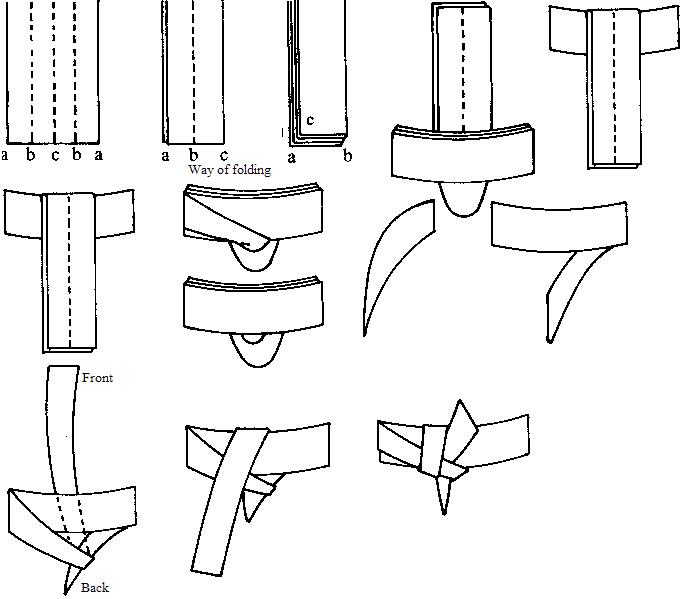
|
| Way of tying the Mawashi |
When passing the loincloth round the body again, let the front end
drop down and secure it with the horizontal cloth. Pass the loincloth back. This fastening is carried out by folding the loincloth
again so that it is folded in eight, passing the end through and under the first part of the horizontal cloth and then tying
it so that it protrudes at an angle, as shown in the drawings on page 16. It is difficult for one person to tie the loincloth
alone so help is needed. In particular, care must be taken that the loincloth is sufficiently tightly tied that it does not
come loose during a bout.
V.4 Conduct of Qualified Judges
All qualified judges associated with this Federation shall be aware
that they are judged as having ample experience of amateur sumo competitions, as having superlative knowledge and skill, and
as being excellently versed in the skills of judging. In judging, they shall be cool, resolute and accurate, and shall make
every effort to raise the level of skill and qualities required for fair judging. In particular, they shall endeavor to see
that, since sumo is the national sport of Japan
that begins and ends with a ritual of courtesy, their conduct can serve as a model to others.
1. The Chief of Judges
1. The chief of judges shall have
overall responsibility for judging.
2. In the event of the chief of judges being incapacitated, the deputy
chief of judges shall take over his duties.
3. The chief of judges, alternating with the deputy chief of judges,
shall be directly responsible for judging competitions as a chief judge. Where the "chief judge" is referred to in the following
text, this shall include the chief and the deputy chief of judges.
4. The chief judge shall impartially observe and ascertain the correctness
of the judgements of the referee and the judges, and take any appropriate action.
5. If the chief judge has any objection or doubt regarding the decision
of the contest, he may communicate this to the referee and request a meeting of the judges.
6. Regarding doubts on the part of the judges, the chief judge is
to arbitrate to ensure the fair running of the contest.
2. The Referee
1. The referee is the central figure among
the judges and is directly responsible for adjudicating on the victor of a bout.
2. The referee must always remember and be conscious of the fact
that his actions have a very considerable influence both on the competitors and on the watching public.
3. He must pay very careful attention to the tachiai of the competitors.
In particular, he must strive to ensure that the tachiai takes place under conditions of complete coordination of the state
of readiness both of himself and of the two competitors.
4. The adjudication of the victor must be completely fair and impartial,
and there must be no sign whatever of wavering.
5. He must make every effort to ensure that the contest can proceed
smoothly, watching in particular to see that the loincloths are firmly tied.
6. In the event of a meeting of the judges, the referee must explain
to the others and provide information on the reason for his decision.
7. On receiving a signal from the timekeeping judge that the time
is up, he must immediately stop the bout and wait for instructions from the chief judge.
3. The Judges
1. The judges must strive to ensure that
there is no error in the verdict given by the referee.
2. If a judge has an objection or doubt regarding the verdict of
the referee, he must immediately make a signal and inform the referee of his objection or doubt.
3. When a judge raises a doubt or objection, he must quickly raise
his right hand and stand up, then the other judges must also stand up.
4. On the occasion of a meeting, each judge has a right to express
Ms own view on the result of the bout.
5. A judge must give a simple and clear explanation of his objection
or doubt.
6. At a meeting of judges a judge must not justify himself so strongly
that free and smooth discussion is impeded.
7. Even if Makite (accidental brushing of the ground by a hand) is
observed during a bout, an objection must not be raised until the adjudication.
8. The timekeeper will be the judge at the front (on the North side)
of the dohyó.
4. Meeting of Judges
In the event of a Meeting of Judges,
arising out of a doubt or objection raised by a judge, due attention must be paid to the following points so that the smooth
running of the competition is not impeded.
1. Before any attempt is made to reach a decision on the basis of
the majority of points, the reasons of the referee for his adjudication must be listened to with all due respect.
2. In principle, victory will go to the competitor with the majority
of points (the majority principle is not affected by the abstention of a judge).
3. As a basic principle, if the distribution of points is equal,
the bout will be replayed.
4. In a case where victory is allocated on the basis of a majority
of points, it is desirable that an effort should be made to gain the understanding of the minority judges regarding the reason
for the decision.
5. When making an announcement regarding points, the decisive technique
must be explained clearly and accurately.
6. Particularly in the case of kabaite, okuriashi, isamiashi, harite,
and utchari, it is especially difficult to reach a precise decision, so in the case of an objection regarding a verdict, a
full explanation must be given since there are likely to be difficulties of understanding.
7. Since it is possible that the minority judges are correct, the
chief judge must deliberate very carefully within the limits allowed by the need to ensure the smooth running of the competition.
5. Concerning Injury
In the event of injury or bleeding
observed during a bout (if this is not observed by the referee, the other judges must inform him immediately), the bout must
be stopped at once and a decision taken at a meeting of the judges as to whether it is possible to continue or not. (In such
a case the judges will deliver a decision based on the extent of the seriousness of the injury):.
6. The Actions and Gestures of the Referee
I. When the
wrestlers get into the ring and carry out the purification the referee must stand upright in the tokudawara on the South side
of the dohyo (also when they carry out the ritsurei or standing ritual).
2. When the wrestlers advance to the center of the ring and adopt
a crouching position (sonkyo), the referee must take two and a half small steps forward and call "kamaete"("get ready!").
3. Following these actions, he should bring his left leg one step
back, then place his right leg at an angle half a step behind, bend both knees slightly and with the palm facing inwards hold
his left arm forwards at an angle, and encourage the competitors to the tachiai.
4. After the shikiri of matta (wait) period, the referee must return
to the position in 2 and repeat once the action in 3 above.
5. When the time of mattanashi (no waiting) comes, (when the wrestlers
are at the starting line shr7cbi for the third time), the referee must take up the position in 2 and say "mattanashi kamaete"("get
ready with no waiting"). Taking one and a half steps back with both legs, he will spread his legs and, bending his knees slightly,
stand with both arms stretched forward and downwards and with the palms facing inwards, and say twice "mada yo, mada yo" ("not,yet,
not yet"), and at the last moment say "hakkeyoi"to the wrestlers, who then carry out the tachiai.
6. The referee must carry out his actions in the dohyo in a swift
and orderly manner, taking care not to cause any impediment to the movements of the wrestlers.
7. The referee must study and practice the ability to take up the
best position from where he can easily observe the outcome of a bout and a posture suitable for delivering the verdict. Ideally,
he should always be in a position to fulfil the above aim during a bout.
8. During a bout the referee must take care not to step on the straw
bags forming the perimeter of the ring or on the fine sand just outside the ring.
9. At the time of delivering the result of the bout, the referee
must indicate with his arm the East or the West player (depending on the side from which they entered) and say "shobu atm"
("the contest is over").
10. At the time of delivering the formal notification of victory,
positions must be taken up as in 1 above, and the referee must stretch out his arm to the winner and say accurately and clearly
"higashi no kachi" ("the East is the winner") or "nishi no kachi' ("the West is the winner").
11. In the case of team contests, before the first bout and after
the last bout, the contestants in each team must line up on the East and West sides of the arena respectively and the referee,
in the position as in 1 above, must instruct them to carry out the `standing ritual' of nodding to each other with the word
"rei".
12. During a competition, the movements of the referee, as described
in the preceding clauses, must be carried out smoothly and continuously.
V-5. The Dohyo
1. The Standard Measurements
of the Dohyo of the Japan Sumo Federation
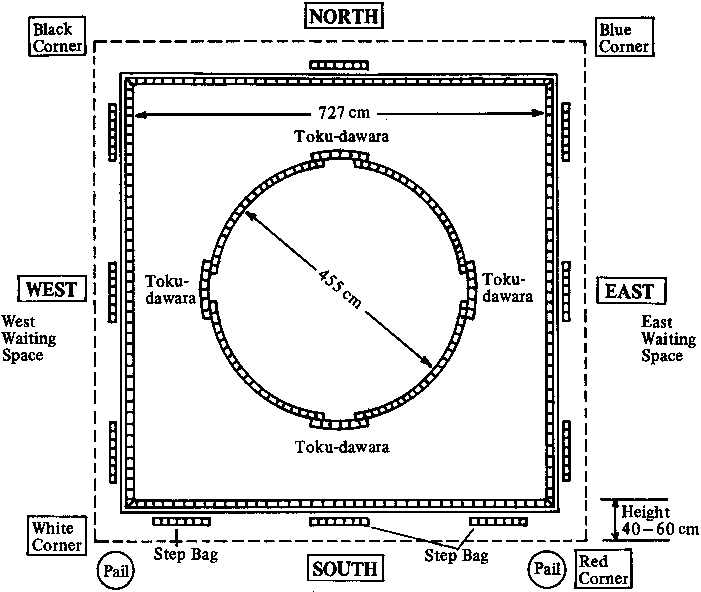
|
| Dohyo |
The internal diameter of the dohyo shall be 4.55 meters.
The straw bags (tawara)
constituting the perimeter of the dohyo shall be 4 cm in height (the part above the surface of the dohyo). The thickness of
the rope joining the straw bags shall be 6 to 8 mm. The standard for the height of the earth constituting the dohyo shall
be 36 cm.
The overall form of the dohyo (i.e. the square enclosing the ring) shall be that of a square with sides measuring
7.27 m. The length of one tawara (straw bag) shall be 818 cm.
If standard tawara are used, the length shall be 63.5 cm
The thickness of a tawara shall be 85 cm to 9 cm. It shall be elliptical in shape and approximately two-thirds shall be buried.
2. The Construction of the Dohyo
There are many traditions which are
associated with the dohyo since ancient times, but in the concept of sumo as a sport the emphasis should be placed on showing
how the splendid sport of sumo can be actively enjoyed within the dohyo.
1. In the construction of the dohyo, the ideal is to use "Arakida clay" (pure
clay as used for supporting walls or for the fastening of slates on a roof, but ordinary red clay is acceptable and it should
be heaped up and firmly stamped flat to provide a firm surface. A suitable height for the raised dohyo is between 30 and 50
cm. For dohyo inside a room or for practice dohyo, provided the drainage is good, the clay does not need to be packed up in
this way.
2. The packed earth should form a square with sides of 7.27 m.
3. The internal diameter of the ring shall be 455 meters; for primary school
children a diameter of about 33 meters is suitable.
4. For the shape of the roof suspended over the dohyo there are various prescribed
forms such as Shinmei, Kiritsuma and lrimoya, but there is no objection to a simple form.
5. For a practice dohyo, if a square with sides longer than 727 meters can be
found, several practices by a number of persons can be carried on.
6. Sand should be firmly sieved and a sufficient quantity should be provided;
it should be evenly scattered, normally within the circular dohyo, and for practice dohyo inside and outside the ring.
7. The bags (tawara) - these are also sometimes referred to as the dohyo - are
usually the bags used to contain rice, but of late these are proving difficult to obtain, so alternatives will be admitted.
8. The boundary of the circular-shaped dohyo marks a very important dividing
line between the victor and the loser, so great care needs to be exercised in burying the tawara which constitute this boundary.
9. Find the center of the square constituting
the dohyo area.
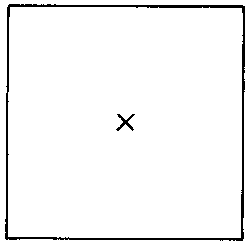
10. Mark out a circle with
a diameter of 455 cm. Remember that at the East, West, South and North points a tokudawara has to be constructed, and at these
points mark out a short arc approximately 10 cm outside the main boundary.
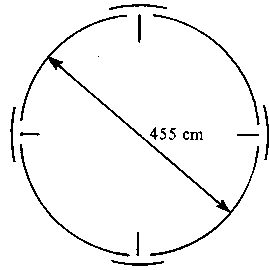
11. Being careful not to disturb the earth within the perimeter of the
circle, dig down vertically along the perimeter, excavating the earth towards the outside. Put this earth to one side and
stamp down the bottom of the trench that has been dug.

12. Lay out the tawara and
pack these firmly into the trench with the excavated earth. Ensure that the firm earth on the inside and outside of the ring
is the same height.

13. The size of the tawara above the ground is normally 10 cm in
width and 4 cm in height.
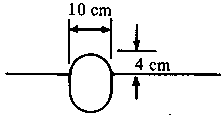
14. Preserving the distance of 10 cm
(one tawara width) outside the circle perimeter, bury the tawara to form the tokudawara recessed space. Make sure that the
length of the intervening stretches from East to South, South to West, West to North and North to East, is correctly adjusted
in relation to the tokudawara.
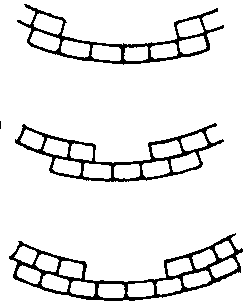
15. If there is only a very slight overlap or if there is a gap between
the bags forming the perimeter of the tokudawara and-that of the circle proper, the adjudication of the result becomes very
difficult, so it is important that the degree of overlap should not be as shown here.
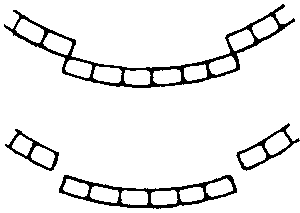
16. During competitions, very fine sand is spread smoothly to a width of
about 20 cm outside the circular dohyo; this is very convenient in facilitating fine judgements when a wrestler steps over
the side of the sing. This sand is called janome.

17. In the central part of the circular dohyo
draw two lines 70 cm apart to form the starting shikiri lines, These are not necessary in practice dohyo.
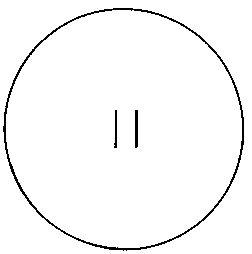
Published by Nihon Sumó Renmei (Japan Sumo Federation) Kishi
Taiikukan, Jin-nan, Shibuya-ku,
Tokyo I50, Japan Tel: (03)481-2377
Edited and written by: Jun-ichi Tabuchi & Kazuaki
Sugiura, M.D. (Nihon Sumo Renmei)
|



